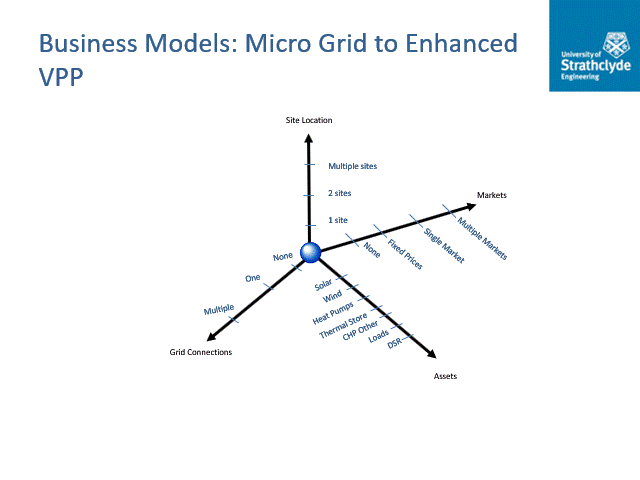Smart Integrated Energy System (SIES) Project
Aggregation by Virtual Power Plants (VPP) to provide flexibility to distribution and transmission networks is seen as an important element in the transition to Net-zero. This website presents work carried out in the SIES 2022 ERA-Net project, which is investigating in detail the possible provision of flexibility by different technologies but thorough a lens of different business models. .
Introduction
Virtual Power Plants (VPP) will form an important element in the development of a future low carbon power market, as they will ease the interactions of system operators with thousands of potential customers. Exactly how these sources of flexibility will be managed and the economic impact on the players is still unclear. The challenge of employing flexibility in generation, consumption and storage in the context of a VPP depends on the appropriate optimization of market access, assets and an understanding of the constraints on the wider distribution system. The Engineering Technology Centre in Central Scotland (ETC) is a partner in the SIES 2022 ERA-Net consortium which has been set up to deliver a technology demonstrator system to manage energy pools using VPP software and to investigate how this VPP could operate using a variety of assets in a realistic setting. ETC has interests in two energy pools which are available for immediate deployment in the project:
- ETC's own premises and the wider Scottish Enterprise Technology Park energy infrastructure
- A test area at the Myres Hill wind turbine site.
The sites include both electrical and thermal loads that can be used for flexibility as well as other consumers in the area. Future DSO/TSO flexibility markets will require the efficient operation of aggregators to ensure the safe and economic operation of the system. An important element of this will be the ability to forecast imbalance volumes and market prices. Using the pilot demonstrator plant introduced above, the effect on the operation of the VPP at this site is shown using different use-cases, both from a technical and economic point of view.
What is a VPP?
There is not one strict definition of what a VPP is but a Virtual Power Plants (VPP) typically have been used to control and schedule larger medium sized assets (> 1MW), so defintions vary. There is no reason why smaller assets cannot be embodied into this definition.
"Depending on the particular market environment, VPPs can accomplish a whole range of tasks, but in in general, the objective is to network distributed energy
resources such as wind farms, solar parks, and Combined Heat and Power (CHP) units, in order to monitor, forecast, optimize and trade their power. This way, fluctuations
in the generation of renewables can be balanced by ramping up and down power generation and power consumption of controllable units. But the VPP not only helps stabilizing the power grids. It also creates the preconditions for integrating renewable energies into the markets. Individual small plants can in general not provide balancing services or offer their flexibility on the power exchanges. This is because their generation profile varies too strongly or they simply do not meet the minimum bid size of the markets.
By aggregating the power of several units, a VPP can deliver the same service and redundancy and subsequently trade on the same markets as large central power plants or industrial consumers". (Next Kraftwerke)
Differences between Microgrids and VPP's
- VPPs are integrated into the grid. Microgrids are often off-grid, and in an on-grid setting, they are designed to be islanded so they can carry on working independently if the grid goes down.
- VPPs can be assembled using assets connected to any part of the grid, whereas microgrids are usually restricted to a particular location, such as a neighbourhood.
- VPPs are managed via aggregation software, offering functions meant to mimic those of a traditional power plant control room. Microgrids rely on additional hardware and switches for islanding, on-site power flow and quality management.
- A VPP has access and interacts with markets (a key difference with a microgrid). Microgrids, on the other hand, are more focused on end-user power supply.
- Microgrids have physical boundaries consumers and DER are defined and mostly can't be changed, while VPPs can integrate a variety of resources and the consumers can be changed.
Note a VPP platform could be used to manage a microgrid but would use only a small portion of its functionality.
General Information on VPP's
Click here to see more details on articles on VPP's, including discussions on the differences between VPP's and Microgrids, and a generic VPP platformBusiness Models
A VPP business can be represented along a mutli dimensional spectrum, including assets , markets, locations and so on. Whether business focuses on one site or many or whether assets are connected to the grid is a matter for the VPP owner/developer (See Figure 1). At one extreme a VPP platfrom could just be used to control assets with one site without connection to the wider grid (essentially a microgrid). At the other it could be used to interface with many sites, many grid connections and many markets.

Target Audience: Who is this site for?
The project was developed to further the development of VPP concpets and uses assets at small scale (kW), to test and prove such concepts. In paricular this website should be useful for:
- Local Communities looking to develop and control assets
- Companies and Indivduals interested in the VPP concept and who want to learn more.
- Those who are interested in developing a VPP.
Site Struture
The site provides a number of useful resources on the lessons and challenges of the SIES Project. Pages can be navigated to using then navigation bar at the top or by using the buttons below. This inscludes a solution library, project description, contact details, videos and downloads.
Use-Cases
Use-cases were developed in the project to prove the functionality of the VPP system and to enable the project team to test out a number of concepts. Use case 1 is the simplest with asset combinations and control complexity increasing with increasing case number. Click on the various buttons to view the particular use-case which includes an animation of the power flows.



